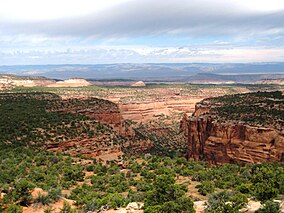| Black Ridge Canyons Wilderness | |
|---|---|
 Knowles Canyon | |
| Location | Mesa County, Colorado / Grand County, Utah, USA |
| Nearest city | Grand Junction |
| Coordinates | 39°06′19″N 108°55′50″W / 39.1052605°N 108.9306622°W[1] |
| Area | 75,439 acres (30,529 ha) |
| Established | October 24, 2000 |
| Governing body | U.S. Bureau of Land Management |
The Black Ridge Canyons Wilderness (BRCW) is located in western Colorado with a small portion extending into eastern Utah, USA, within the arid Colorado Plateau region approximately 15 miles (24 km) west of Grand Junction, Colorado. The wilderness lies on the northwest flank of the Uncompahgre Plateau. It is characterized by the high, east-west trending Black Ridge dissected by seven major canyon systems, draining into the Colorado River in Ruby Canyon. Elevations range from 4,700 feet (1,400 m) above sea level along the river to 6,800 feet (2,070 m). Canyons vary in length from several miles to twelve miles in length and may contain interesting side canyons. Geological features in these canyons include spires, windows, giant alcoves and desert varnish. Canyons may reach a depth of almost 1,000 feet (300 m), forming spectacular red rock cliffs. Spring runoff and summer thunderstorms create glistening waterfalls and plunge pools. Rattlesnake Canyon contains the second largest concentration of natural arches in the country. Mee Canyon is even more remote, and contains Arch Tower.
Vegetation in the meandering canyon bottoms includes grasses, pinyon, juniper, cottonwood, willow and box elder. The upland mesas contain dense stands of pinyon and juniper with some sagebrush parks. Cryptobiotic soils are well developed in the upland areas. Wildlife viewing may include deer, mountain lion, desert bighorn sheep, along with golden and bald eagles. The wilderness area is 75,439 acres (305.29 km2) of which 70,319 acres (284.57 km2) are in Colorado and 5,120 acres (20.72 km2) are in Utah. It was designated by the U.S. Congress in 2000 and is administered by the Bureau of Land Management. The Black Ridge Canyons Wilderness forms the core of the 123,430 acres (500 km2) McInnis Canyons National Conservation Area.
